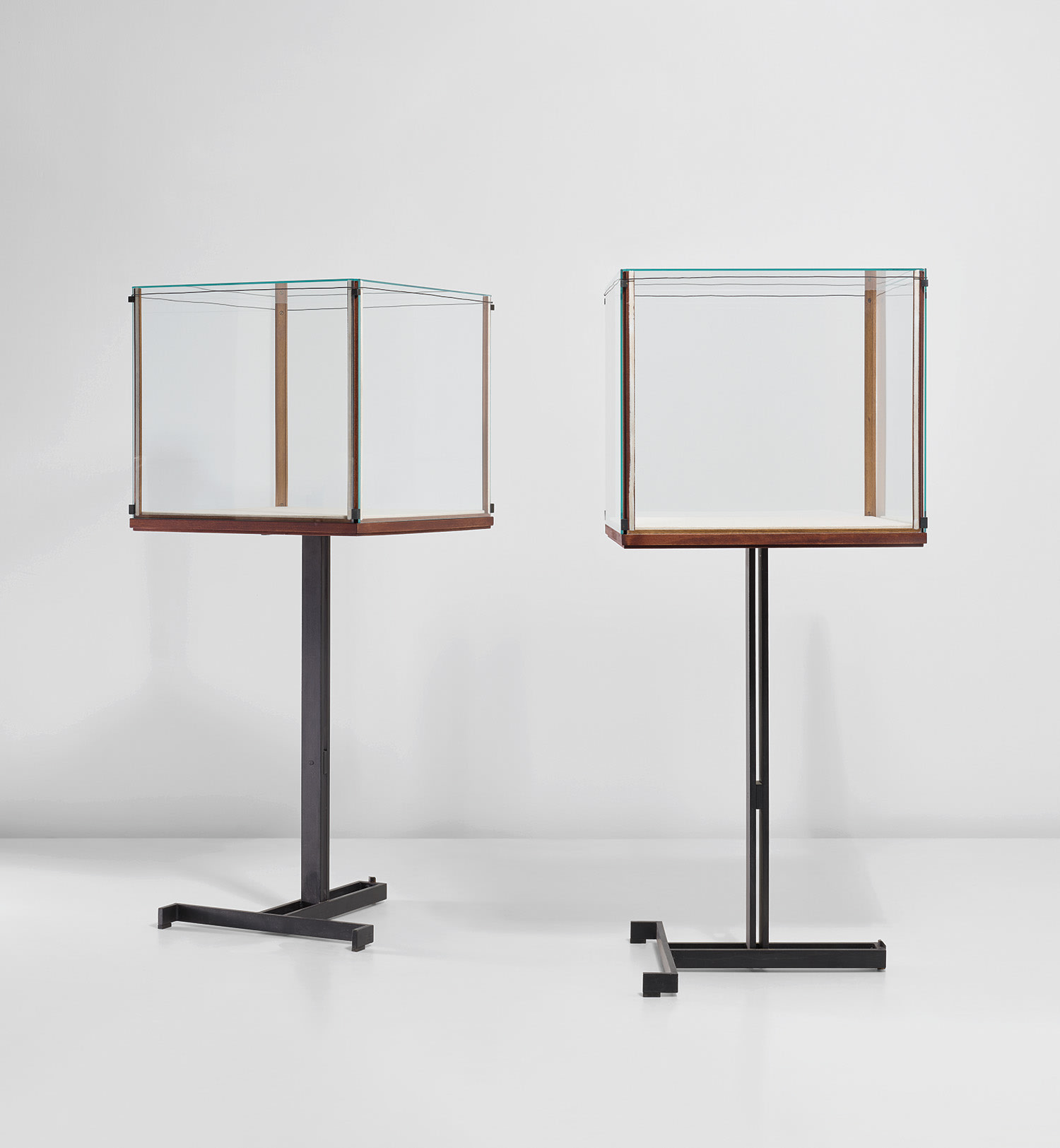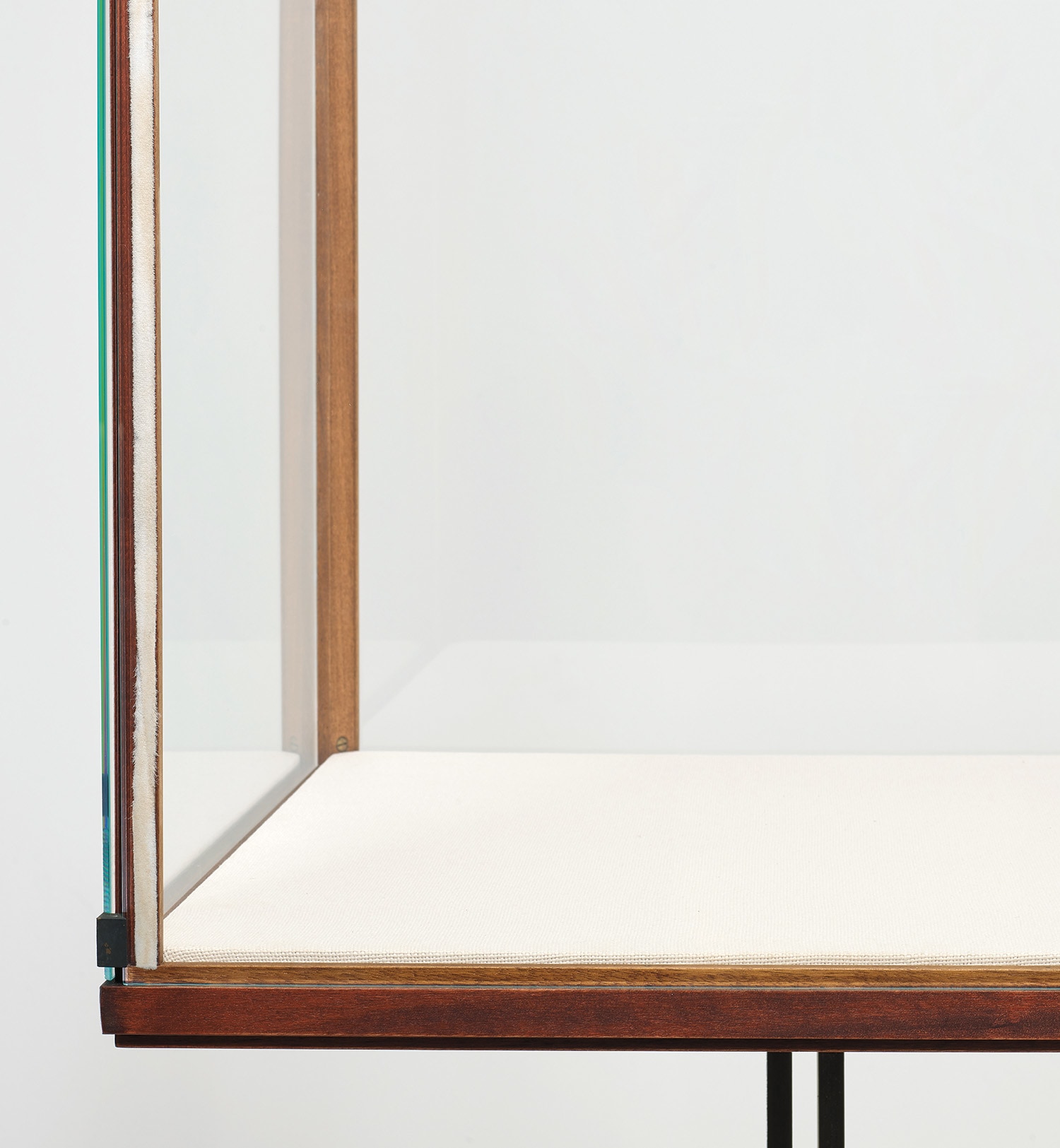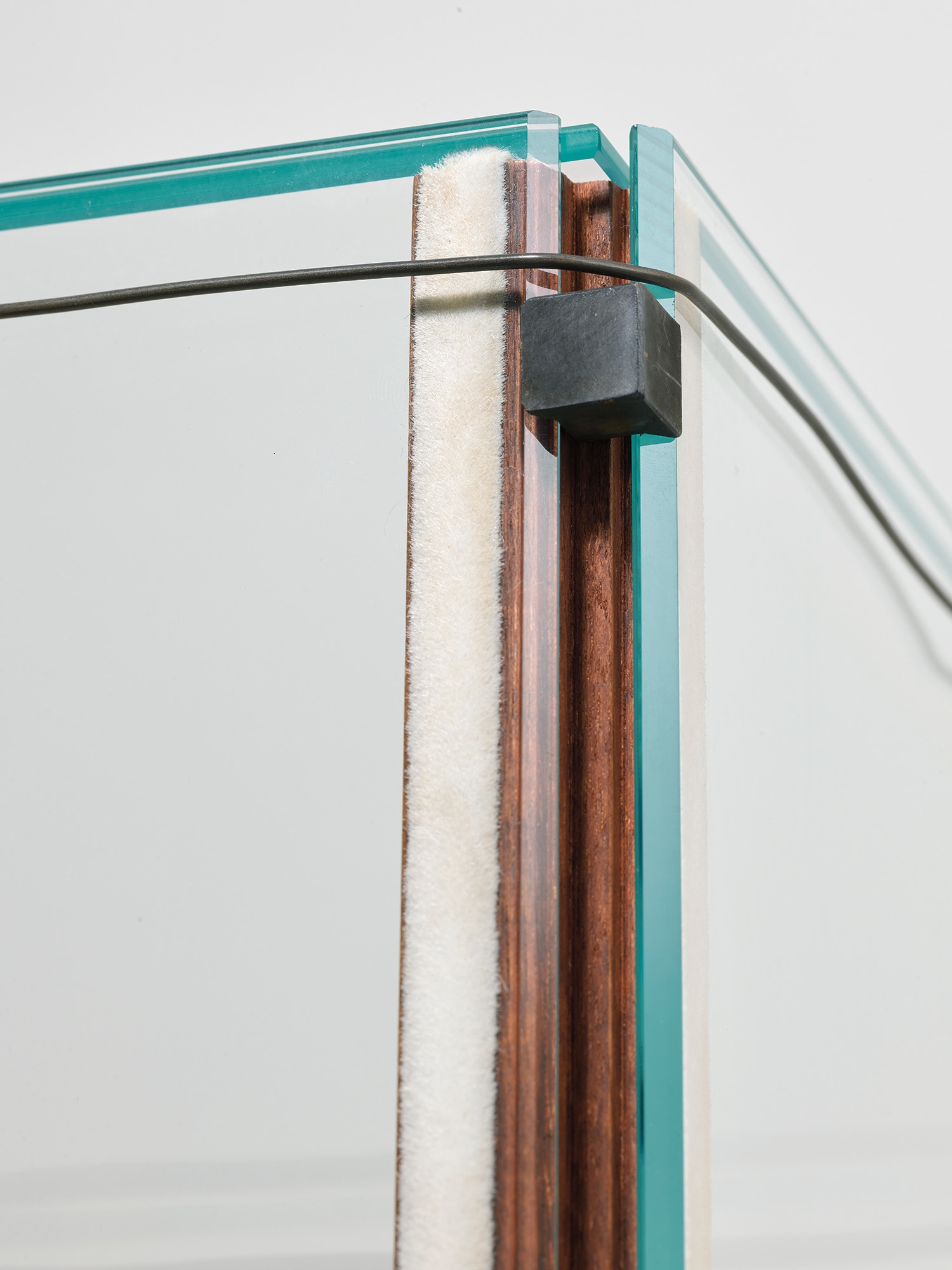









12
Carlo Scarpa
Pair of vitrines
Full-Cataloguing
The present pair of vitrines can be traced to Dino Gavina and were probably commissioned by him for the opening of the Gavina store in Bologna in 1963. The vitrines were later given by Gavina to one of his employees, who until recently has kept them in his care. Whereas the examples of the model from the Gipsoteca Canoviana in Possagno were executed in the workshop of Paolo and Francesco Zanon, it is unknown who worked on the Gavina store and it is thought that the present vitrines were executed by one of the local workshops that Gavina and Carlo Scarpa worked with on the project. Having closed in 1997, the former Gavina store has recently been carefully restored. On the occasion of the project’s completion last year, the present vitrines were temporarily installed to be photographed in situ. The present vitrines are the only known examples produced during Scarpa's lifetime to have come to the market.
Creating and Defining Space: A Pair of Vitrines Designed by Carlo Scarpa
Carlo Scarpa originally conceived the design of the present vitrines for the extension of the Gipsoteca Canoviana in Possagno. To commemorate the bicentenary of the Italian neoclassical sculptor Antonio Canova’s birth, the Superintendent of Fine Arts commissioned Scarpa to extend the existing museum. Built during the 1830s, the basilica-like building housed the plaster and terracotta models from Canova’s studio in Rome, which following the sculptor’s death in 1822 were brought back to his birthplace of Possagno, a small village in the Veneto region. Completed between 1955-1957, Scarpa’s comparatively small extension of the museum’s plaster-cast galleries embodies his sensitive understanding of materials, resolute interest in the essential, and above all, the Venetian architect’s mastery of light. Scarpa built his reputation as an architect through his re-imagining of historical museum interiors and his innovative approach to exhibition design that have had a lasting influence on the field. Expressed through the visual languages of neoclassicism and modernism, Scarpa’s designs for the Gipsoteca Canoviana exemplified his ability to harmoniously unite the past with the present, extending from the overall building down to each interior detail.
The commission for the Gipsoteca Canoviana is rare among the architect’s many remarkable museum interiors in that Scarpa’s placement of natural light sources was largely unconstrained by the existing historical building. Scarpa’s use of glass and steel gave the building an expressive quality through which light became more nuanced, allowing for the study of subtle changes and its effects on the surfaces and volumes of the artwork and the surrounding architecture. The smooth plaster walls, marble floors with floating steps, and white painted steel posts and beams create layered abstract planes into which Scarpa situated Canova’s plaster casts without spatial hierarchy: on low pedestals, mounted to the walls and displayed in a series of vitrines. Scarpa’s focus on essential lines and use of limited materials allowed his designs to respond to the variety of forms and scale of the artwork, while retaining a visual and spatial continuity within the galleries. The supports and their placement within the multileveled plan ensure the sculptures are in intimate connection with the viewer, informally guiding their movement throughout the space and offering moments of pause. Scarpa closely studied the works in a collection in order to infuse the objects with renewed life through a dialogue with the viewer and their architectural context. He conceived the exhibition in response to the specificities of each artwork in order to facilitate a direct intellectual and emotional response from the viewer.
Scarpa conceived the design of the present free-standing vitrines for the display of Canova’s small figurative sculptures. The vitrine’s glass-walled form is supported by a thin wooden frame set on a steel base, elevating the floating volume to the viewer’s eye-line. The relative transparency and lightness of the rectilinear design enabled Scarpa to integrate the delicate sculptures into the spatial structure of the galleries. In response to the layout and light sources, for some examples Scarpa angled the glass at 45 degrees to the base. Within the galleries, the voluminous glass cases become another layer, creating and defining space occupied by both the viewer and the historical objects. This sense of layering is enhanced by Scarpa’s choice of materials, which is repeated in the large steel and wooden frame windows in the ‘horizontal’ gallery. Similarly, the base’s double vertical form, which Scarpa often incorporated into his designs, references the frames of the pair of inward-penetrating windows in the ‘vertical’ gallery. The use of materials in the design of the vitrines and the galleries delineate their junctions, reflecting Scarpa’s interest in the border or edge, and how they act to clarify individual volumes and how the objects within them are perceived. The design also highlights Scarpa’s characteristic attention to joints. The five planes of glass never meet and are fixed by small brass clips at each corner and secured by a delicate wire. Within the highly articulated galleries, the layered horizontal and vertical planes of the vitrines create additional space, activated by a continual interplay of light and shadow, line and volume.
Scarpa’s work stands out among modern architecture for its ability to transform a particular historical place and integrate it into the larger contemporary world. In addition to his many museum projects, Scarpa designed exhibition spaces for commercial interiors. Having been awarded the Olivetti prize in 1956 in recognition of his architecture, the following year Scarpa received the commission to design the new Olivetti store (1957-58) on Piazza San Marco. It was in 1958 at the XXIX Venice Biennale that Scarpa met the designer and entrepreneur Dino Gavina. One of the great protagonists of Italian industrial design, Gavina was an early manufacturer of furniture by many of the country’s influential modernist architects, including Scarpa, Achille and Pier Giacomo Castiglioni, Ignazio Gardella, Luigi Caccia Dominioni and Marco Zanuso. In 1960, Gavina founded the furniture production company Gavina S.p.A, and later Flos co-founded with Cesare Cassina in 1962 and Simon International with Maria Simoncini in 1968. In the first years of what would become a lifelong friendship, Gavina appointed Scarpa as the company’s president and commissioned the architect to design the first Gavina store, located on via Altabella in the historic centre of Bologna.
Located on the ground floor of a historic three-story building, Scarpa’s architectural intervention to the external facade appeared radically new within the existing urban context. Extending across the width of the facade’s masonry structure, Scarpa installed a reinforced concrete panel with chiselled texture, divided geometrically by three recessed gold leaf bands. The concrete facade is punctuated by three large apertures: a circular window, an L-shaped entrance and second window composed of two large interlocking circles—the vesica piscis motif that the architect employed in nearly all his projects. Scarpa approached the design of the store’s interior as he did with exhibitions for painting or sculpture, setting the furniture against an individual background that would enhance each of the industrial objects. In order to create a more unified space, Scarpa replaced the existing partitions with five large concrete pillars, each with different surface treatment, that geometrically defined the interior. From the golden-coloured plaster ceiling to the mosaic of enamelled tiles made by Mario De Luigi, the interior’s richness of colours and materials evoke the Byzantine art of Scarpa’s native Venice. Within the framework of the historical building, Scarpa created a complexly layered space through which contemporary design could be clearly presented. In an interview published in Stile Industria in 1960, Scarpa explained, ‘The store I have designed for [Gavina] in Bologna...I hope it will prove worthy of the things he produces and that it may endure for those he intends to make in the future’.
Carlo Scarpa
Italian | B. 1906 D. 1978Phillips Design has a deep-rooted passion for the work of Carlo Scarpa, one of the twentieth century's great poets, whose rhythms, lines and materials — a grammar of space — appeal both as a local response to the architect's birth city, Venice, and a universal language of ordered dynamism.
Carlo Scarpa graduated with a degree in architectural drawing from the Accademia di Belle Arti in Venice in 1926. In the years that followed, he worked as a teaching assistant for a former professor, ran his own architectural practice in Venice and worked as a freelance artist for M.V.M. Cappellin glassworks. When M.V.M. Cappellin went bankrupt in 1932, Scarpa joined Venini & C. in Murano, where he served as artistic director until 1947. During his tenure at Venini, Scarpa developed a host of new techniques — in particular, mezza filigrano, a bollicine and corroso — that catapulted the centuries-old tradition of Venetian glassblowing to the forefront of modernist design.